Different types of rocks
Many landscape features are made of rock but not all rock is the same. There are three types of rock: sedimentary, igneous and metamorphic.
In this article you can learn:
- How different types of rock are formed
- What causes ripple marks in sedimentary rocks
- How tectonic plates can move rocks
This resource is suitable for Landscapes topics for primary school learners.
Video - Rock types
Join Isla and Connor as they learn about different rock types in the North West Highlands Geopark.
Watch this short video to find out about different types of rock.
ISLA: Look at the shape of this rock, Connor!
CONNOR: Good find! Thatās a ripple mark left by water that used to sit on top of this before it was rock. This used to be sand and other sediment - that's why it is called sandstone - which is a type of sedimentary rock.
Sedimentary rocks are formed when pieces of rock are eroded, or worn away, and carried along by wind, ice or water then deposited, or dropped.
This is sediment. If the sediment is buried deeply, it becomes crushed and compacted until it hardens, forming sedimentary rock.These ripples were made about 1000 million years ago.
ISLA: Marks left such a long time ago, and theyāre still here for us to see!
CONNOR: Yes! That reminds me of another place where rocks have helped solve the puzzle of how the land formed. Come on, Iāll show you!
Weāre at Knockan Crag in the North West Highlands GeoPark. Geoparks are areas that are recognised because the way their landscapes formed and the rocks they are made of can help us understand the processes that shape our planet.
And thisā¦is the Knockan Puzzle wall!
ISLA: Are these rocks here naturally?
CONNOR: Well the rocks are all found here, but the wall has been put here deliberately to show the different rock types and layers here at Knockan Crag and nearby.
ISLA: So why is it a puzzle?
CONNOR: Usually, the deeper underground the rock is, the older it is. Like how sedimentary rock forms in layers, building up over time. So the oldest rock is usually at the bottom and the youngest at the top - but here, the oldest rock is on top!
ISLA: Really? So the oldest rock here, Moine Schist, was somehow pushed on top of younger rock like the limestone and quartzite. That really is a puzzle!
CONNOR: It was a mystery for ages, but it has been solved! Come on, letās go and look!
So not all rocks are formed like sedimentary rocks. There are two other types of rocks.
The Moine Schist, the puzzling old rock found on top of younger rock here, is called a metamorphic rock.
Metamorphic rocks are created when other types of rock become very hot or are squeezed under enormous pressure, or heat ā usually deep underground where tectonic plates meet.
ISLA: Oh ā those are the pieces of the Earthās crust that sit on top of the mantle, that's the layer of hot, moving rocks. They make up the different landmasses?
CONNOR: Yes. There is a rock called Lewisian Gneiss in this area, the oldest rock in Western Europe. The same rock type is found in Canada and Greenland, way across the Atlantic. That tells us that they used to be connected to the land that now makes up Scotland.
Right across what is now the Highlands, tectonic plates pushed into each other, forcing the older rocks of one plate up and over the younger rocks of the other. It showed how tectonic plates move rocks.
ISLA: So what other ways do rocks form?
CONNOR: Letās find some Lewisian Gneiss and Iāll tell you!
ISLA: So, is this it?
CONNOR: Yes, the Lewisian Gneiss! It started as an igneous rock, which means it was made from magma, the molten rock under the earthās crust.
When molten rock cools and hardens it forms igneous rock. Layers of igneous rock are called igneous āintrusionsā because it intrudes into other rock layers. They can form in different shapes, vertically or horizontally, or in a big lump.
ISLA: If it only started as an igneous rock, what is it now? Did it become metamorphic?
CONNOR: Yep! It was put under great pressure under the earth and became a metamorphic rock.
ISLA: Wow, itās incredible how the rocks tell the story of how this landscape was created. What a journey ā almost as good as ours, Connor.
What are the three types of rocks?
There are three main types of rock:
- Sorry, something went wrongCheck your connection, refresh the page and try again.
- Sorry, something went wrongCheck your connection, refresh the page and try again.
- Sorry, something went wrongCheck your connection, refresh the page and try again.
What is sedimentary rock?
Sedimentary rocks are made up of tiny broken pieces of rocks, crystals or mineralA natural solid compound, like calcium or copper. Minerals make up rocks, sand and soil. They can be found on and underneath Earth's surface. They can also be found in food and we need some minerals to stay healthy. .
- Rock breaks and is erosionWearing away over time. into tiny pieces and moved by wind, ice or water.
- The bits of rock are depositionWhen material, like sand and gravel, is transported by wind or water and dropped somewhere new. somewhere new.
- Deposits build up in layers called sediments.
- The layers of sediment become crushed and compacted until they harden to form sedimentary rock. It can take millions of years for sedimentary rocks to form!
- For example, limestone is a sedimentary rock made of calcium carbonate. Learn more about limestone here: Limestone landscape
Here are some examples of sedimentary rocks:
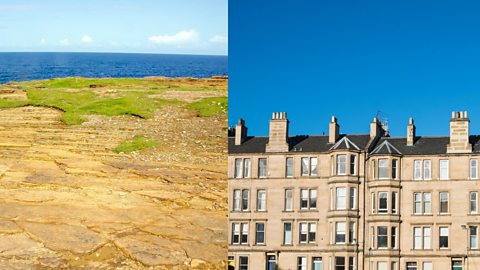
Image caption, Sandstone
Sandstone is a type of sedimentary rock made up of layers of sand. It is a soft rock which means it wears away quickly. It is great for building with and it is often used to build houses, like these tenements in Edinburgh (right). (Iain Masterton / M. Timothy O'Keefe / Alamy Stock Photo)
Image caption, Limestone
Limestone is a sedimentary rock. It is made of calcium carbonate which can be dissolved by rainfall to form landscape features like this limestone pavement in the Yorkshire Dales in England. (travellinglight)
Image caption, Shale
Shale is a kind of sedimentary rock made of silt, clay and other minerals. This rockface of stacked shale can be seen at St Mary's Loch in the Scottish Borders. (Keith Jardine)
1 of 3
What are ripple marks?
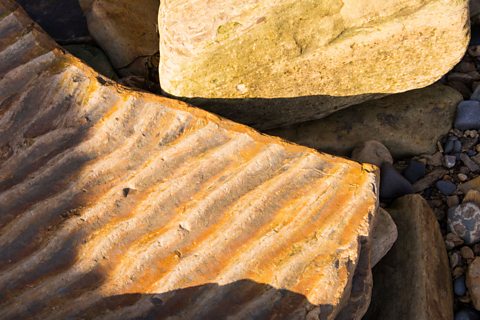
- Ripple marks form when wind or water moves loose sediment, like sand. The wind or water creates grooves in the sediment.
- Ripple marks can often be spotted on beaches when waves come up onto the shore and move the sand.
- Over time, these marks can fossilise, which means the ripple marks have been preserved. This happens when layers of sediment have become compacted and formed sedimentary rock, like sandstone, but the ripple marks have been left behind.

What is igneous rock?
- Igneous rocks are formed from magmaMolten rock that is located deep below the Earthās surface. Magma can escape when deep cracks in the Earth's crust appear or when volcanoes erupt. Magma that reaches the Earth's surface is called lava. or lavaMolten rock that reaches the Earth's surface. When molten rock is beneath or within the Earth's crust, it is called magma..
- Rock from the Earth's crust and mantle becomes molten because of changes in heat and pressure.
- Some of this molten magma rises up through the Earth's crust.
- The magma cools down as it rises. Some of it solidifyWhen something becomes hard or solid. underground. Some of it rises to the surface as lava before it solidifies.
- Learn more about igneous rock formations here: Igneous landscape
Here are some examples of igneous rocks:
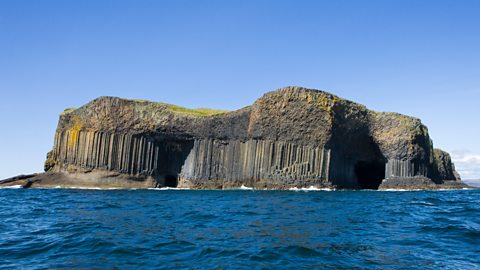
Image caption, Basalt
Basalt rock is a type of igneous rock created by lava that has cooled down. The Isle of Staffa in the Inner Hebrides is known for its dramatic columns of basalt rock. (Derek Croucher / Alamy Stock Photo)
Image caption, Granite
Granite is formed when magma slowly cools and solidifies underground. It is made up of lots of small pieces, which makes it very hard and strong and gives it a speckled appearance. Aberdeen (left) is known as the Granite City because many of its buildings have been constructed with granite. (Lynne Sutherland / Mark Sunderland Photography / Alamy Stock Photo)
Image caption, Pumice
Pumice is a type of igneous rock with lots of tiny bubbles in it. It is formed during really explosive volcanic eruptions where a lot of gas is released. The molten rock cools very quickly and the gas bubbles disappear leaving lots of little holes behind. (Alan Curtis / Alamy Stock Photo)
1 of 3
What is metamorphic rock?
A metamorphic rock starts out as one type of rock but changes into another. For example, a metamorphic rock can be formed because of high heat or high pressure.
Here are some examples of metamorphic rocks:

Image caption, Schist
Schist is a grey-green metamorphic rock formed when sedimentary rocks have been squashed and changed by heat and pressure. Schist can be found all over the Scottish Highlands, like the rocks at Farleitter Crag in the Cairngorms National Park. (Alan Wilson)
Image caption, Gneiss
Gneiss is a metamorphic rock which means it is made up of bits of igneous or sedimentary rocks. It is known for its unique layers and bands. There are cliffs made of gneiss on the east coast of Rassay (above). (Andy Sutton / Alamy Stock Photo)
Image caption, Slate
Slate is another kind of metamorphic rock. In Scotland, there is a group of islands in the Inner Hebrides called the Slate Islands. This slate quarry on the Isle of Easdale (left) is no longer in use but was once part of the booming Scottish slate industry. (Graham Uney / Jeremy Sutton-Hibbert / Alamy Stock Photo)
Image caption, Marble
Marble is a metamorphic rock made up of different calcium rich rocks, like limestone or dolomite. It has a veiny appearance. The Isle of Iona was once home to a marble quarry (left). The marble from Iona is white with yellow-green markings (right). (Neil Dangerfield / Iain Sarjeant / Alamy Stock Photo)
1 of 4
Tectonic plates

Different rocks can be transformed into metamorphic rocks when tectonic platesLarge slabs of solid rock that form the Earthās crust. They are like the pieces of a large jigsaw puzzle that fit together and are separated by fault lines. Tectonic plates slowly float around on a thick layer of hot, molten and semi-molten rock called the mantle. The movement of tectonic plates can create mountains and seas or cause earthquakes and volcanic eruptions. push into each other. The older rocks of one tectonic plate are forced up and over the younger rocks of the other plate.
This is how Lewisian Gneiss was formed. The Lewisian Complex is found in the north west of Scotland and contains some of the oldest rocks in the world! Some of this rock is more than three billion years old.
Learn more about tectonic plates here: Tectonic movement


Key words about rock types
- geopark - An area that is recognised because of its geological importance. Geology is the scientific study of rocks and stones.
- sedimentary rock - A soft rock made up of tiny broken pieces of rocks and crystals.
- sandstone - A type of sedimentary rock.
- deposition - When sediments, soil and rocks are moved by wind, ice, water or gravity and left behind.
- sediment - Materials such as stones and sand that is moved from once and deposited in another.
- ripple mark - Wavy marks or ridges left on sand, mud or rock by the movement of water or wind.
- metamorphic rock - A rock that started out as another type of rock but has been changed. For example, a metamorphic rock might be formed because of high heat or high pressure.
- tectonic plates - Large slabs that fit together to make up the Earth's crust.
- magma - Molten rock that is so hot it has turned into liquid. When magma reaches the surface of the Earth it is called lava.
- mantle - The layer beneath the Earth's crust. In the upper parts of the mantle the rock is hard, but lower down the rock is soft and beginning to melt.
- igneous rock - Rock that was made from magma.
- igneous intrusion - A type of rock feature that forms when magma (molten rock) cools below the surface of the Earth.
Test your knowledge
Quiz
Challenge

Make a poster about a rock type.
Choose from sedimentary, igneous and metamorphic rocks and design a poster all about this rock type.
Ideas to think about for your poster:
- How is the rock formed?
- What are some examples of this type of rock?
- Where might you find this type of rock?
If you need some help designing your poster, take a look at this guide: How to make a poster
More about rocks
Explore Scotlandās Geology and learn about our planetās history.
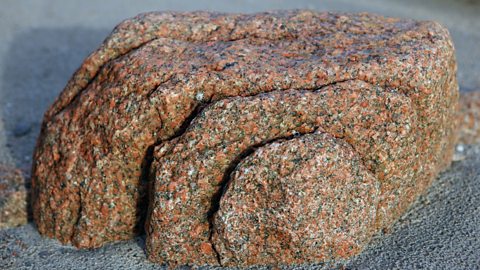
Limestone landscape. revision-guideLimestone landscape
Join Isla and Connor as they explore limestone, a type of sedimentary rock.
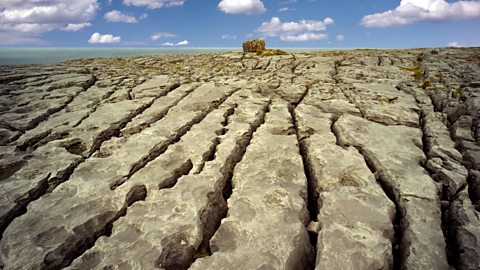
Igneous landscape. revision-guideIgneous landscape
Join Isla and Connor as they explore igneous landscape features.
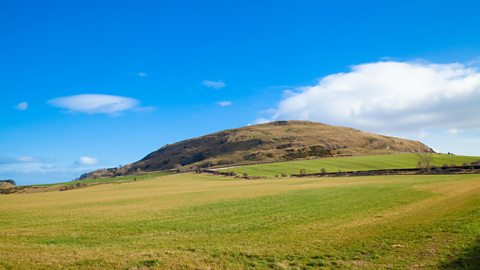
More on Landscapes
Find out more by working through a topic
- count21 of 25

- count22 of 25

- count23 of 25

- count24 of 25
